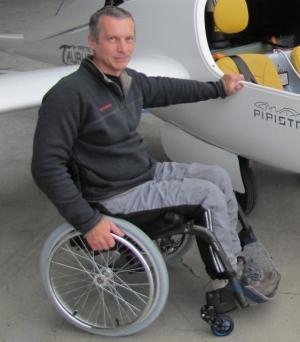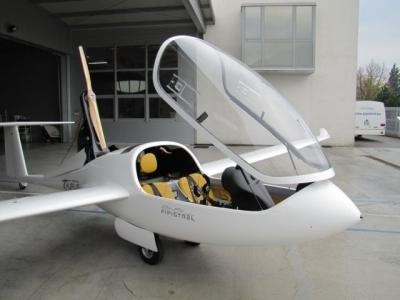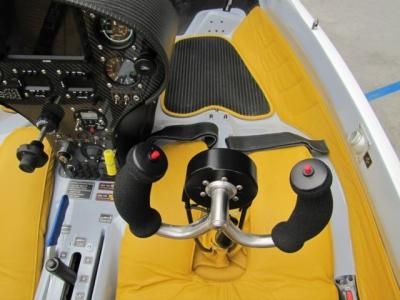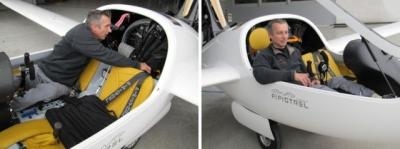Specially-Modified Pipistrel Tarus Gives Him Freedom Of
Flight
(Excerpted from the Pipistrel February
Newsletter)
"Actually, I have always dreamed of flying," Jan Hercek began
his story.
Jan Hercek

"When I was in the third grade of elementary school, that's nine
years old in my country (Slovenia, formerly Yugoslavia), I started
to draw sketches of aircraft and pretend-calculations on how to
make an aircraft fly. I lived in a small village, about 50 houses
– no more than maybe 200 people. So I was pretty alone in my
daydreaming about aircraft. I had no idea how to make my dream a
reality, so I just drew sketches and did my calculations. At the
time – remember, I was just a child – I knew very
little maths, mostly just addition and subtraction, but I remember
reading somewhere in a paper that it was important to know the
ratio between the weight of the airplane and the surface area of
wings, and that there should be some proportional coefficient, so I
started to make some calculations with the assurance of a 9-year
old.”
Hercek had been told that learning to fly was impossible for
someone who wore glasses. "This broke my heart," he said. Back in
the communist regime, things were very black-and-white.
"I wanted to be in the air – somehow, anyhow! This was the
most important thing for me, my biggest wish, the thing of
paramount importance in my life – then nothing else for a
looong time, and then other things like school, job etc. I remember
someone asking me if I wanted to go to a military school to study
electronics – things like radio connections and so on. It was
all the same to me, not really interesting, but I went anyway, just
to have a chance to maybe get close to some aircraft. After
several years I realized that I made two big mistakes: Firstly,
going to the military was a big mistake because it largely limited
my free time and the freedom of movement, and it didn’t allow
me to be myself. Secondly, I started to realize that there in fact
was a possibility to fly even for a person who is wearing
glasses."
Hercek began parachute training in Brno, where he met his future
wife. "She also frequented the parachute training course but she
didn’t have any intention to actually jump from the airplane.
She told everyone she was afraid to jump. She said she was there
because she enjoyed the company, the people and the training."

However – when the time came to actually make the jump,
she was the first of the entire group to jump out of aircraft!
Hercek said she had lost all her fear during the training and
performed the jump flawlessly. He followed her out of the
airplane.
The military moved him to a vililage near Bratislava, where he
took up hang gliding just to get back in the air. "That was in
1984. I lost no time and started my hang-glider training
immediately. The school had one old Rogalo hang-glider which flew
like a stone; it had a gliding ratio of 1:4, I think. We needed a
very steep slope to be able to fly at all. But that didn’t
stop me from having a great time. I was flying! The upside of
serving in the military meant that I had enough money to be able to
buy my own first Rogalo, which had the gliding ratio of 1:8 –
for the time, that was fantastic!”
Jan takes a sip of his drink and a deep breath. His face
doesn’t lose its perpetual happy smile when he moves to the
next part of his story.
“The next year, maybe year and a half, was a really great
time for me. But the dream was short-lived. I had a terrible
accident with the Rogalo. I remember trying to land in a valley. It
looked like I would be able to land safely, but just before the
touch-down, one wing caught the lee rotor and it flipped me over -
at 40 km per hour the hang-glider stopped dead and slammed into the
ground. I didn't hit the ground bodily, but the deceleration force
spread my vertebrae and tore the nerves and ligaments. I remember
feeling no pain at all – but I couldn’t feel my legs
either. I couldn’t move.
"I remember my first thought to be: “Well, if I'm not able
to walk, it means I will be out of the army. So I will be able to
do all the things I always wanted and didn’t have the time
for before. I spent a lot of time in the hospital. The doctors just
didn’t know what to do with me. Nobody could help me.
Altogether, I spent about a year in the hospital. When I was
finally discharged, I found myself in a wheelchair - with some
minimum retirement payment which was enough to cover a roof over my
head – and nothing else."
He and is wife Jane moved to Piestany. "As soon as I got out of
the hospital, I started to make plans on how to adapt the Rogalo,
to add a trike where I could sit and all manual commands, so I
would be able to fly again – but my wife put her foot down.
She gave me an ultimatum; it was either living with her, or
flying.
It was a hard decision!
Hercek chose his wife. "I think it was a good decision at the
time, I don’t regret it at all. So I spent next 25 years
enjoying a beautiful, very happy marriage, despite it being
childless. The life was great once again, it was really perfect
– I spent all my time with my wife, a lot of working,
talking, laughing together. We were as one.
Then, she was diagnosed with cancer. It spread lightning fast.
Within 2 years, she was gone. "My world collapsed once again. This
was the hardest time of my life – we had been really close.
We had spent every possible moment together, we were always
together, we never spent a single day away from one another. I
plunged into deep gloom and grief."
While Jane Hercek battled cancer, they had hired a professional
assistant who worked with the disabled, who continues in his employ
to this day.
Hercek worked hard at staying involved in aviation. He learned
to fly aerobatic RC helicopters, and became close friends with the
shop owner over the course of many visits to buy spare parts and
keep his machine flying. The shopkeeper was also a glider pilot and
also a glider instructor, and invited Hercek to join him for a ride
in the glider plane. He decided that he wanted to own one.
But at the time, in all of Slovakia , there were no aircraft at
all which would be suitable for disabled people. "When I started to
think about the aircraft, I was the only person in Slovakia who
wanted an aircraft, adapted for the use of paraplegics, at least as
far as I knew. There were several steps to overcome this obstacle.
The first thing I needed was a lot of money to buy my very own
aircraft. I was sure that there was no chance whatsoever that
another owner would let me adapt their aircraft. The second they
asked me how I became a paraplegic – I crashed an aircraft
– they became reluctant to even let me into their plane, let
alone let me tinker with it. There was no way I would ever convince
an owner to let me change the commands on their plane."
He decided he would use the money he had his wife had saved for
a down payment on a house to purchase an aircraft.

The next issue was getting a medical, no small feat for a
paraplegic. He did some research and found that there was a
provision in the law that would allow him to obtain the medical
certificate, but was still told flatly by an AME that it was
impossible. He managed to convince the doctor that he would be able
to buy a specially-modified aircraft to allow him to fly without
the use of his legs.
The doctor finally relented and agreed to the medical exam.
"We agreed on the date of my visit. I was a bit nervous, but
when I visited him, he turned out to be a completely different
person. In the phone conversation, he had tried to discourage me
from trying to become a pilot to save me all the disappointment,
prevent me from losing my time and keep me out of trouble. But when
I visited him in person and he saw my determination, he encouraged
me and thought hard of all the ways in which he could help me. He
thought of all the little tricks how I could overcome the
obstacles. Slowly we became friends."
Other doctors, including the neurologist who had treated him
since his accident, were also skeptical. "I entered his office and
gave him the paper with the title: “Permission to fly”.
He stared at the paper so hard that his eyes bulged out on the
head! He looked at me and then said to his medical assistant: 'Look
at him! He wants to fly! He is crazy! We can't allow him to do it!'
But he was smiling, so I knew that he was partly joking. I told
him, smiling, that I really wanted to fly – that it was the
biggest wish in my life - and that when I pass every possible check
and test, he will have to allow me to fly. So the doctor performed
his tests, he checked my coordination, made me follow his finger
with my eyes; he even tapped my knees with his hammer.
When he finished, he looked me in the eyes and asked: “Do
you really want to fly?”
“Yes!” I said.
“Really REALLY?”
“Yes, there’s nothing I want more in my
life!”
“Fine then! I will sign your paper. But I will never sit
into the aeroplane with you!!”
"I burst into laughter.
"Imagine my pride when I appeared back on the doorstep of the
AME doctor's office with a big bunch of papers. The doctor took the
exam results and checked them one by one. I heard him murmur:
'Good, okay, perfect…' When he finished, he looked at me and
said: 'Very well. Now I will write a document that you cannot fly.'
I felt as if a bucket of cold water was dumped on my head. Shocked,
I stammered: “Why?!” The doctor explained: “You
see, due to your condition I cannot give you a direct permission to
fly. So I have to refuse it. But I will immediately write another
paper for the committee to re-evaluate your case. They will most
probably confirm my findings and tell you that you cannot
fly.”
"That wasn’t what I wanted to hear!
“You can’t be serious!” I said. But the doctor
smiled. “Ah, but you see, then you have the right to
objection. I will then write a third letter, addressed to the
lawyers at the Slovak Flying Association Office and they will have
no choice but to allow you to fly, because I see that you legally
passed all the medical checks!”
Hercek said it took about six months for the appeals process to
work its way through the system. He eventually was granted a
medical certificate.
But then came the critical decision: What aircraft to buy.
Hercek already knew he wanted a glider, and determined that a
self-launching aircraft would give him the most freedom. He also
needed to be able to get into the airplane without help, be able to
carry his wheelchair, and have room for an instructor so he could
learn to fly it. The only aircraft which met all the criteria was
the Pipistrel Taurus. Actually, I didn’t find it myself
– a friend of mine told me that it existed. He also told me
about Mr. Lukaš Benedict, who was a distributor for the
company which produced the Taurus.
I thought for a while and then took my phone and gave Mr
Lukaš a call. I asked him for a demonstration of the Taurus.
He agreed immediately. My plan was to go to Senica and to give the
Taurus a careful examination to see if I fit in the cockpit and if
I can get in and out without help.
"When I arrived, Lukaš told me: “The weather
situation is really bad, unfortunately… The cloud layer is
at 800m… but since you came all the way here, we’ll go
flying anyway!” That was a nice surprise for me! From the
moment we took off I was sure that this was it! In that very moment
I have made my decision and I stopped searching for other aircraft.
But I didn’t tell this to Lukaš immediately - I wanted
to allow myself a few days to think it over once I calmed down from
the initial excitement. Still, I was convinced I had made the right
decision. So I went back to Lukaš to discuss details,
equipment and prices. All my decisions were very careful and
well-thought-over; I wanted the airplane customized in the exact
way I knew I would need it. This is a way of thinking that not many
costumers do, but disability forces you to plan ahead carefully. My
motto was: “Know what you want and don’t stop until you
get it!”
"The one thing that had nothing to do with my needs was the
yellow colour of the seats I ordered for my Taurus. The reason for
this was that my Jane was a really big fan of flowers and she liked
yellow flowers the most. So I decided it would be nice to remember
her in this way. I ordered yellow seats in her memory. One of the
most troubling questions I had was: how to put my wheelchair in the
aircraft?" That problem was solved by putting a smaller set of
wheels on the chair to allow it to fit in the baggage
compartment.

"Then we approached what seemed to be the greatest construction
challenge: how to adapt the controls of the aircraft for a man who
has no use of his legs. It was obvious from the very start that the
hand controls will need to be adapted. Again it was Lukaš
who pointed out to me a company in Austria which produced horn-type
hand controls. I knew about the Schemp – Hirth which had the
option with a side-stick solution for rudder steering, but I
didn’t like it because I don't have three hands – and
with yet another stick to control besides the airbrakes, you would
need three when landing! The horn-type controls would be the best
known solution. Before ordering, though, I called to Austria and
asked to be allowed to fly this type of aircraft. The answer was
positive so I went to Niederöblarn “LOGO” airport.
I spent 3 days flying there with a G103 Twin Astir adapted to
hands-only controls to decide if this was what I wanted or not. The
three days I spent there were amazing! I could fly! I had full
controls, I was able to do everything myself! I was flying in the
Alps which was much different from flying over the lowland
Slovakia. It was very nice. I returned from Austria with rock-hard
certainty that this was what I wanted ad nothing would stop me from
getting it!"
"The big moment finally came! The very next day I called
Pipistrel and ordered my Taurus. I placed two conditions – I
wanted it adapted for the hands-only controls and with a space for
my wheelchair. I was surprised because the answer was very positive
and very welcoming. The general manager, Ivo Boscarol, invited me
to visit the company. To prevent any unwelcome surprises, I bought
a set of hand-controls, the exact ones that I wanted, in advance.
Then I prepared my wheelchair and set off to Slovenia with a very
clear picture in my head about how I wanted the aircraft to look
and to behave - on the ground and also in the air."
Hercek was involved through much of the process of building his
airplane. On his second visit to the Pipistrel factory, he got is
first flight in his new Tarus.
"Nejc, the Pipistrel test pilot, was the one who flew with me
and from my point of view he was just perfect. When I arrived to
Slovenia, I had idea - a plan what I wanted to do for each day of
flying. Nejc also had his own schedule and I was surprised to find
out that we agreed almost in 100% on all the things to do on each
day.
"We started very carefully. Nejc took off and in mid-air he
simply asked me to hold the controls and fly straight. I was
surprised; it was much easier than the Twin Astir. I knew I needed
a few hours of practice – after all, it is not so easy to
control the entire aircraft with hand controls only, because you
need to move your hands very precisely in all 3 directions. A
standard pilot will have a lot of trouble adapting to the fact that
every move matters, not just left and right but also the twist of
your wrist – but it was easier than I expected and very soon
I was flying!
"I was really happy - this plane behaves so much better than the
Twin Astir! The controls work well, they are much softer and easier
to handle and I need less force to operate them. The Taurus is more
agile and not so lazy in its reactions. The thing I like the most
is that is it so predictable. I admit I can only compare my
experience with the aircraft I flew in the simulators, but they
behaved differently, more erratically. After several hours of
practice it started to feel very natural for me and it became quite
easy to manipulate this type of controls.
"On the first day Nejc made me do some left and right turns,
some circles, and some eight-figures. I was still not completely
happy with my flying because I was not able to avoid a bit of
slipping of the aircraft in the turn, but slowly I was getting
better. Then, suddenly, Nejc said: “Okay, now you
land.” To my surprise he allowed me to do the complete
landing sequence. The first landing was a bit bumpy and so it
remained until I truly understood how to safely bring the aeroplane
down and stop it - pull the horns and also pull the airbrakes. I
was able to do it perfectly by the day 2.

"On the second day I surprised Nejc a bit because I asked him if
it was possible for him to show me how to recover form stall and
spin. Later on, Nejc admitted that he didn’t believe it was
possible, but after I recovered perfectly the first time I tried
it, he started to trust me and he said he was convinced I would be
safe. The second day was mostly about the emergency procedures,
which I didn’t like, but it was a thing that you need to know
to help yourself if you ever find yourself in such a situation.
"At the end of the day I got another surprise. Nejc switched the
engine off and said: “Engine failure simulation - Land
without retracting the engine!”
I started to shake and I thought to myself: “Noooooo, I
can’t do this!” So when we were landing without the
engine for the first time, I was completely frozen with fear and
Nejc had to take over the controls. But already on the second
landing I got rid of my fear and all the rest were performed
flawlessly. So within two days we covered the most important steps
of my glider training. In any case, I am here alive and smiling,
Nejc too, and the plane is in still in perfect shape with no
scratches.
"Unfortunately the weather was too bad to fly on the third day,
so I decided to return to Slovakia.
The Pipistrel crew packed my shiny new Taurus in a trailer and
off I went, so overjoyed I could barely move!"
Jan Hercek summed up his experience in a concise thought.
"Whatever you think is impossible, is really impossible for you.
And whatever you think is possible, it really is possible for you,
just don't be afraid to try it. Make a plan, consult with your
friends and with the experts, with everyone who can help you - and
follow your dreams. Life is easy. So keep smiling and be
happy!"
 ANN's Daily Aero-Term (04.14.24): Maximum Authorized Altitude
ANN's Daily Aero-Term (04.14.24): Maximum Authorized Altitude ANN's Daily Aero-Linx (04.14.24)
ANN's Daily Aero-Linx (04.14.24) Classic Aero-TV: 'We're Surviving'-- Kyle Franklin Describes Airshow Life 2013
Classic Aero-TV: 'We're Surviving'-- Kyle Franklin Describes Airshow Life 2013 Aero-News: Quote of the Day (04.14.24)
Aero-News: Quote of the Day (04.14.24) Airborne 04.09.24: SnF24!, Piper-DeltaHawk!, Fisher Update, Junkers
Airborne 04.09.24: SnF24!, Piper-DeltaHawk!, Fisher Update, Junkers







